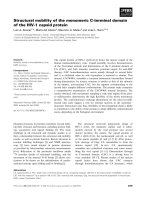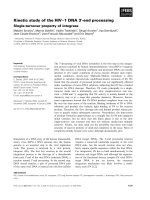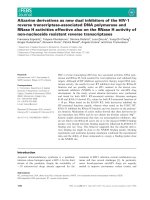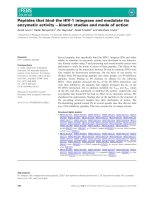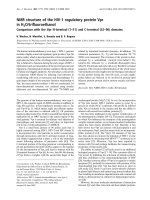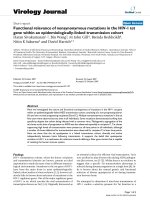Survey of cellular factors modulating the HIV 1 integration complex activity using a unique protein screening system in vitro
Bạn đang xem bản rút gọn của tài liệu. Xem và tải ngay bản đầy đủ của tài liệu tại đây (2.82 MB, 125 trang )
SURVEY OF CELLULAR FACTORS MODULATING THE
HIV-1 INTEGRATION COMPLEX ACTIVITY USING A
UNIQUE PROTEIN SCREENING SYSTEM IN VITRO
TAN BENG HUI
B.Sc (Honours), National University of Singapore
A THESIS SUBMITTED
FOR THE DEGREE OF MASTER OF SCIENCE
DEPARTMENT OF MICROBIOLOGY
NATIONAL UNIVERSITY OF SINGAPORE
2013
ACKNOWLEDGEMENT
I would like to extend my heartfelt gratitude to Dr Youichi Suzuki for
his undue patience in guiding me for my experiments and towards the
completion of this project. Special thanks to Dr Yasutsugu Suzuki for
pioneering the project and contributing towards the establishment of the
microtiter plate-based assay. Also, I would like to thank Dr Hirotaka
Takahashi and Mrs Chikako Takahashi for their guidance in the use of wheat
germ cell-free technology and the production of protein libraries, and Miss
Han Qi’En for her assistance in stable cell-line production and infection
studies. All the help and advice from Prof. Naoki Yamamoto and the lab
members are also deeply appreciated.
I
TABLE OF CONTENTS
ACKNOWLEDGEMENT ............................................................................... I
TABLE OF CONTENTS ............................................................................... II
SUMMARY ................................................................................................... VI
LIST OF TABLES ....................................................................................... VII
LISTS OF FIGURES ................................................................................. VIII
LIST OF ABBREVIATIONS ...................................................................... IX
CHAPTER 1: INTRODUCTION ................................................................... 1
1.1 Introduction to HIV and its replication cycle .......................................... 1
1.2 HIV-1 mortality and challenges in the current treatment ........................ 3
1.3 Developing novel therapeutics through targeting host-pathogenic
crosstalk ......................................................................................................... 4
1.4 HIV-1 integration—a key step in the HIV-1 replication cycle involving
viral IN and a multitude of host factors ......................................................... 5
1.4.1 HIV-1 IN protein............................................................................... 5
1.4.2 The mechanism of HIV-1 integration process .................................. 6
1.4.3 Host proteins found to associate with HIV-1 IN .............................. 8
1.5 Ubiquitination and phosphorylation of HIV-1 IN by host factors ......... 13
1.5.1 Role of protein kinases in stabilization of HIV-1 IN ...................... 13
1.5.2 Involvement of ubiquitin ligases in the degradation of HIV-1 IN .. 14
1.6 HIV-1 PIC as a better target of study than recombinant IN .................. 17
1.6.1 Cellular components and modulators of the pre-integration
nucleoprotein complex (PIC) ................................................................... 18
1.6.2 Hurdles to the use of PICs in high-throughput screening studies ... 22
1.7 Aims and objectives ............................................................................... 23
CHAPTER 2: MATERIALS AND METHODS ......................................... 24
2.1 Preparation of target DNA-coated microtiter plate ................................ 24
2.2 Preparation of HIV-1 PIC ...................................................................... 24
2.2.1 Cell culture ...................................................................................... 24
II
2.2.2 HIV-1 vector production ................................................................. 24
2.2.3 HIV-1 PIC isolation ........................................................................ 25
2.3 Production of human E3 ubiquitin ligase library ................................... 25
2.3.1 Cloning of human E3 ubiquitin ligase cDNAs ............................... 25
2.3.2 Wheat germ cell-free expression of human E3 ubiquitin ligases ... 26
2.3.3 Purification of human E3 ubiqitin ligases ....................................... 27
2.4 Screening of human E3 ubiquitin ligases using in vitro PIC integration
assay ............................................................................................................. 28
2.4.1 Microtiter plate-based assay ........................................................... 28
2.4.2 Quantification of integrated products by PCR ................................ 28
2.5 Evaluation of candidate E3 ligases using from E.coli-derived
recombinant proteins .................................................................................... 29
2.5.1 Construction of plasmid DNA for bacterial protein expression ..... 29
2.5.2 E.coli expression of candidate proteins .......................................... 29
2.5.3 Purification of GST-tagged candidate proteins from E.coli
expression ................................................................................................ 30
2.5.4 Microtiter plate-based assay using GST-tagged candidate proteins
from E.coli expression ............................................................................. 30
2.6 Production of RFPL3 mutant proteins ................................................... 31
2.6.1 Expression of RFPL3 mutants using wheat germ cell-free
technology ................................................................................................ 31
2.6.2 Purification of RFPL3 mutant proteins and PIC integration assay . 31
2.7 Other in vitro experiments involving RFPL3 ........................................ 32
2.7.1 Gel-shift assay ................................................................................. 32
2.7.2 In vitro PIC integration assay with MoMLV PIC ........................... 32
2.7.3 AlphaScreen interaction assay with recombinant HIV-1 IN .......... 32
2.8 Cell-based studies .................................................................................. 34
2.8.1 Construction of lentiviral vectors expressing candidate genes ....... 34
2.8.2 Establishment of cell-lines stably expressing candidate proteins ... 34
2.8.3 Immunofluorescence analysis ......................................................... 35
2.8.4 Immunoprecipitation analysis of HIV-1 PIC .................................. 35
2.8.5 HIV-Luciferase assay on RFPL3-expressing 293T cells ................ 36
III
CHAPTER 3: RESULTS .............................................................................. 37
3.1 Establishment of a novel in vitro microtiter plate-based PIC integration
assay for the identificaiton of host modulators ............................................ 37
3.2 Production of human E3 ubiquitin ligases by wheat germ cell-free
system .......................................................................................................... 42
3.3 A preliminary screen for HIV-1 PIC modulators using the human E3
ubiquitin ligase library ................................................................................. 45
3.4 Validation of candidate PIC modulators— effect of E. coli-produced
candidate E3 ligases on PIC activity ............................................................ 51
3.5 Characterization of RFPL3 as an in vitro enhancer of HIV-1 PIC ........ 54
3.5.1 Determination of the functional domain in RFPL3 essential to the
enhancement of PIC activity in vitro ....................................................... 54
3.5.2 DNA-binding ability of RFPL3 ...................................................... 58
3.5.3 Effect of RFPL3 on integration activity of MoMLV PIC............... 60
3.5.4 Interaction of RFPL3 with HIV-1 IN.............................................. 62
3.6 Cell-based validation studies ................................................................. 65
3.6.1 Cellular localization of candidate E3 ligases .................................. 65
3.6.2 Association of RFPL3 with HIV-1 PIC in infected cells ................ 68
3.6.3 HIV-Luciferase assay on infected RFPL3-expressing 293T cells .. 70
CHAPTER 4: DISCUSSION ........................................................................ 72
4.1 The importance of the study .................................................................. 72
4.1.1 Clinical significance: Developing treatment strategies targeting the
HIV-1 integration process with minimized resistance development ....... 72
4.1.2 Scientific significance: Advancing knowledge on the aspects of
retroviral integration through the revelation of PIC modulators and its
components .............................................................................................. 74
4.2 Establishment of novel microtiter plate-based PIC integration assay in
combination with wheat germ cell-free protein production system for the
screening of host modulators ....................................................................... 76
4.2.1 The wheat germ cell-free protein production system ..................... 76
4.2.2 Evaluation on the effectiveness of the microtiter plate-based PIC
integration assay for proteins ................................................................... 77
4.2.3 Restrictions on the screening process and selection of candidates . 78
IV
4.3 Introduction to candidate proteins ......................................................... 81
4.3.1 Potential HIV-1 PIC enhancers ....................................................... 81
4.3.2 Potential HIV-1 PIC inhibitors ....................................................... 83
4.4 Mechanism of RFPL3 in mediating enhancement of PIC activity ........ 85
4.4.1 Comparing the conserved domains of RFPL3 with that of a protein
of known effect on HIV-1 to elucidate a possible mechanism of action . 85
4.4.2 Evaluation on the experimental results of RFPL3 .......................... 86
4.4.3 Proposed model of enhancement of HIV-1 PIC integration activity
by RFPL3 ................................................................................................. 90
CHAPTER 5: CONCLUSION AND FUTURE WORK ............................ 92
5.1 Summary of results ................................................................................ 92
5.2 Future work ............................................................................................ 94
REFERENCES............................................................................................... 96
APPENDIX ................................................................................................... 104
A1 Primer information ............................................................................... 104
A2 Protein expression profile .................................................................... 105
A2.1 CBB and western blot analysis for 72 Batch A proteins............... 105
A2.2 CBB and western blot analysis of 63 Batch B proteins ................ 109
V
SUMMARY
The human immunodeficiency virus type 1 (HIV-1) is the causative
agent of acquired immunodefiency syndrome (AIDS), a disease that had
affected at least 34 million people worldwide by the end of 2011. Anti-HIV
drugs that are currently in use mainly target the active sites of viral enzymes
such as reverse transcriptase or viral proteases. However, the high mutation
rates of these active sites often lead to the rapid emergence of viral strains
resistant to available drug regimes. As such, a new generation of antiviral
drugs is necessary. HIV-1 establishes a permanent infection in the host cell
when the viral DNA genome is integrated into host chromosomal DNA. This
integration process is mediated by a cytoplasmic nucleoprotein complex,
namely the preintegration complex (PIC), which comprises of core
components including viral cDNA, integrase (IN) protein and other viral and
cellular proteins. Despite the lack of knowledge on the exact structure and
composition of the PIC, studies have demonstrated the exploitation of various
cellular factors to modulate PIC activity thereby affecting HIV replication.
Hence, understanding the molecular aspects of virus-host interactions in the
integration step should provide new insights into alternative strategies for the
treatment of HIV infection by targeting cellular factors. Since the new drug
target is a host factor, it is also less likely that resistant viral strains will arise.
Studies have shown that the HIV-1 integration is actively modulated
via the ubiquitin-proteasome pathway, whereas the E3 ubiquitin ligase that
regulates the PIC function has not been identified. The revelation of such will
provide additional knowledge to the regulation of HIV-1 IN, potentially
guiding the development of antiviral strategies targeting at the integration step.
In our research, we developed an in vitro assay monitoring PIC integration in a
high-throughput setting, to identify novel E3 ubiquitin ligases involved in HIV
integration. The assay system is applied to a preliminary screen using an
available human E3 ubiquitin ligase library of proteins. Amongst the candidate
proteins identified, we found that RFPL3 enhances integration activity of
HIV-1 PIC in vitro, and this effect was likely to be attributed to its N-terminal
RING domain. Further study is required to fully elucidate its mechanism in the
enhancement of HIV-1 integration.
VI
LIST OF TABLES
Table 1.1
List of cellular cofactors that interact with IN to
12
modulate HIV-1 replication processes in the early
phase.
Table 1.2
List of protein kinases and ubiquitin ligases that affect
16
the stability of HIV-1 IN.
Table 1.3
List of cellular components/modulators of PIC
21
identified by various group of researchers through
reconstitution analysis or immunoprecipitation assays.
Table A1.1
Primer sequences for amplification of ORF for E3
104
ubiquitin ligase clones from MGC library.
Table A1.2
Primer sequences for amplification of ORF for
104
candidate proteins selected from preliminary
screening.
Table A1.3
Primer sequences for amplification of RFPL3 N’-
104
terminal truncated mutants.
Table A2.1
Protein expression profile of 72 E3 ubiquitin ligases
107/108
from Batch A.
Table A2.2
Protein expression profile of 63 E3 ubiquitin ligases
from Batch B.
VII
111/112
LISTS OF FIGURES
Figure 1.1
An overview of the HIV-1 replication cycle.
2
Figure 1.2
Structural domain of HIV-1 IN.
6
Figure 1.3
Illustration of the 3 biochemical steps in HIV-1 integration.
7
Figure 3.1.1
Schematic diagram of microtiter plate-based PIC integration
38
assay in vitro.
Figure 3.1.2
Quantification of integrated HIV-1 DNA by microtiter plate-
38
based PIC assay.
Figure 3.1.3
Preparation of GST-tagged BAF and VRK.
39
Figure 3.1.4
Modulation of PIC integration activity by BAF and VRK in
40
vitro.
Figure 3.1.5
Assessment of PIC assay by Z-factor.
41
Figure 3.2.1
Gel electrophoresis of 2nd PCR products.
42/43
Figure 3.2.2
CBB staining and immunoblotting analysis to check on
44
purity and expression of proteins produced.
Figure 3.3.1
Screening profile for Batch A E3 ubiquitin ligases.
47/48
Figure 3.3.2
Screening profile for Batch B E3 ubiquitin ligases.
49/50
Figure 3.4
PIC assay with candidate proteins produced by E. coli.
53
Figure 3.5.1
Effect of RFPL3 domain mutants on in vitro PIC integration
56/57
activity.
Figure 3.5.2
Gel-shift assay to test the DNA-binding activity of RFPL3.
59
Figure 3.5.3
Microtiter plate-based in vitro PIC assay with RFPL3 using
61
MoMLV PIC.
Figure 3.5.4
AlphaScreen assay to check the in vitro interaction between
63/64
RFPL3 and HIV-1 IN.
Figure 3.6.1-1
Immunoblotting analysis to check the expression of
65
candidate proteins in 293T cells.
Figure 3.6.1-2
Localization of candidate proteins in 293T cells.
67
Figure 3.6.2
Co-immunoprecipitation analysis of HIV-1 PICs derived
69
from RFPL3-expressing 293T cell line.
Figure 3.6.3
HIV-1 luciferase assay on RFPL3-expressing 293T cell line.
71
Figure 4
The proposed mechanism of action by RFPL3 in modulating
91
HIV-1 PIC and its effect on early HIV-1 replication cycle.
VIII
LIST OF ABBREVIATIONS
1-MI
1-methyl-imidazole
AIDS
Acquired immunodeficiency syndrome
ARVs
Antiretroviral drugs
BAF
Barrier-to-autointegration
BLAR
Blasticidin resistance
BSA
Bovine serum albumin
Btnl
Butyrophilin-like
Btn
Butyrophilin
CA
Viral capsid protein
CBB
Coomassie brilliant blue
CCD
Catalytic core domain
CTD
C-terminal domain
Cul2
Culin2
DAPI
Diamidino-2-phenylindole
DHFR
Dihydrofolate reductase
DMEM
Dulbecco's modifed Eagle’s medium
DTT
Dithiothreitol
ECL
Enhanced chemiluminescence
EGFP
Enhanced green fluorescent protein
ELISA
Enzyme-linked immunsorbent assay
ENV
Viral envelope glycoproteins
EVG
Elvitegravir
FCS
Fetal calf serum
FDA
US Food and Drug Administration
FPLC
Fast protein liquid chromatography
FRET
Fluorescence resonance energy transfer
HAART
Highly active antiretroviral treatment
IX
HAT
Histone acetyl transferases
HDAC
Histone deacetylases
HECT
Homologous to E6-APC terminus
HEK
Human embryonic kidney
HhH
Helix-hairpin-helix
HIV-1
Human immunodeficiency virus type 1
HR
Homologous recombination
HRP
Horseradish peroxidase
IFA
Immunofluorescence assay
IN
Viral integrase protein
InSTIs
Integrase strand transfer inhibitors
IPTG
Isopropyl-beta-D-thio-galactopyranoside
IVT
In vitro transcription
JNK
C-Jun NH2-terminal kinase
LAP2α
Lamina-associated polypeptide 2α
LDL
Low-density-lipoprotein
LEDGF
Lens epithelium-derived growth factor
LTR
Long terminal repeat
MAPK
Mitogen-activated protein kinases
MATH
Meprin and TRAF homology
MoMLV
Moloney murine leukemia virus
MOI
Multiplicity of infection
MYLIP
Myosin regulatory light chain interacting
protein
NHEJ
Nonhomologous end-joining
NTD
N-terminal domain
ORF
Open reading frame
PCR
Polymerase chain reaction
PIC
Preintegration complex
X
PPI
Protein-protein interaction
PR
Viral protease
PTM
Post-translational modification
RDM
RFPL-defining motif
RFP
Ret finger proteins
RNF
Ring finger protein
RT
Viral reverse transcriptase protein
RTC
Reverse transcription complex
SDS
Sodium dodecyl sulfate
SDS-PAGE SDS-polyacrylamide gel electrophoresis
siRNA
Small interfering RNA
SMN
Survival motor neuron
SMPPII
Small molecular protein-protein interaction
inhibitors
snoRNP
Assembly of nucleolar ribonucleoproteins
snRNPs
Spliceosomal small nuclear ribonucleoproteins
TAE
Tris acetate-EDTA
TAP
Tandem affinity purification
Tat
Trans-Activator of Transcription
TNF
Tumour necrosis factor
TPR
Tetratricopeptide repeat
TRAF
Tumor necrosis factor receptor-associated factor
TRIM
Tripartite motif-containing protein
VBP1
Von Hippel-Lindau binding protein 1
VHL
Von Hippel-Lindau
VRK
Vaccinia-related kinases
VSV-G
Vesicular stomatitis virus G
β-ME
Beta-mercaptoethanol
XI
CHAPTER 1: INTRODUCTION
1.1 Introduction to HIV and its replication cycle
The HIV is a lentivirus belonging to the Retroviridae family with two
distinct species, namely HIV-1 and HIV-2. HIV-1 is more virulent and
infectious, accounting for majority of HIV cases (Levy, 2009). The enveloped
HIV-1 particle carries two copies of positive sense single-stranded RNA. Each
strand is 9.7 kb in length and encodes three major proteins, namely the Gag,
Pol and Env, as well as other regulatory and accessory proteins. Flanking the
ends of the RNA are the 5' and 3' long terminal repeat (LTR) sequences that
play important roles in the replication cycle.
HIV-1 infects a spectrum of immune cells including CD4+ helper T
cells, macrophages, and microglial cells (Cunningham et al., 2010). Its
replication cycle can be classified into two phases—early and late phase
(Figure 1.1). During the early phase, viral envelope (Env) glycoproteins
recognize and interact with cell surface protein CD4, stimulating a
conformational change that allows gp120 portion of Env to bind to other
coreceptors such as chemokine receptor CXCR4 or CCR5. This induces the
refolding of Env gp41 which then mediates membrane fusion and viral entry
(Nisole and Saib, 2004). In the host cytoplasm, the virion begins to uncoat its
capsid (CA) proteins to release the viral genome and other essential proteins,
allowing reverse transcription to begin. Host cellular cofactors and essential
viral enzymes such as reverse transcriptase (RT) and integrase (IN) form a
reverse transcription complex (RTC) where they work in concert to produce
viral DNA from the RNA genome (Warrilow et al., 2009). The newly
synthesized viral DNA remains associated with various viral and host proteins,
forming the preintegration complex (PIC). This PIC plays a major role in
facilitating the integration of viral DNA into the host genome in the nucleus
(Bushman and Craigie, 1991). Nuclear translocation of the PIC is conjectured
to be mediated by the presence of karyophillic signals carried by either viral or
cellular proteins that are part of the PIC, although the exact mechanism is
poorly defined (Fouchier and Malim, 1999).
During the integration process, the HIV-1 establishes a permanent
infection in the host cell when the viral DNA genome is inserted into host
1
chromosomal DNA. The integration process begins in the cytoplasm where IN
catalyzes the 3’-end processing of the viral DNA. Following nuclear entry of
the PIC, IN binds to and cleaves host chromosomal DNA to mediate strandtransfer of the viral DNA. Finally, cellular repair enzymes fill up the nicked
gaps to complete the integration process (Suzuki et al., 2011). The integrated
viral DNA, now a provirus, is transcribed as part of the host genome,
producing viral genes at the expense of host resources.
The late phase of the viral replication cycle begins with the
transcription and translation of the viral RNA genome, consisting of the Gag,
Pol and Env genes (Gallo et al., 1988). Precursor polyproteins including Gag
(p65) and Gag-Pol (p160) were produced, of which the latter resulted from a
ribosome frameshifting near the 3' end of Gag gene prior to the start of Pol
(Jacks et al., 1988). The precursor polyproteins are subsequently cleaved by
viral protease (PR) to form the matured forms of the structural and enzymatic
proteins including IN. Eventually, packaged virions bud out of the host cell
membrane and the matured progenies can then begin the next round of
infection (Al-Mawsawi and Neamati, 2007).
Figure 1.1: An overview of the HIV-1 replication cycle. Early phase of the cycle include
viral entry, reverse transcription of viral RNA, nuclear translocation and integration of viral
cDNA. Late phase of the cycle involves proviral gene expression and viral RNA translation
using host machineries, assembly of new virion progenies, budding, maturation and infection
of new targets. (Al-Mawsawi and Neamati, 2007)
2
1.2 HIV-1 mortality and challenges in the current treatment
HIV remains a mortality threat with 34 million people infected
worldwide at the end of 2011 (UNAIDS, 2012). Although there is no cure for
HIV, there are at present 34 antiretroviral drugs (ARVs) approved by US Food
and Drug Administration (FDA) for the control of HIV infection. A majority
of these ARVs are inhibitors that target viral enzymes essential to various
stages of the viral replication cycle, including RT, PR and IN. A compelling
regimen for HIV infection involves a cocktail of ARVs, and this forms the
basis of a typical highly active antiretroviral treatment (HAART) (Arts and
Hazuda, 2012). However, these inhibitors act on the active sites of their target
viral proteins. Since the HIV has a relatively short replication cycle and its
reverse transcriptase replicates with low fidelity, these viral enzyme active
sites have an innately high rate of mutation (FDA, 2013). As a result, the
mutations often lead to the emergence of drug resistant viral strains that are
able to evade and survive the actions of their respective ARV inhibitors.
Consequently, existing ARVs are usually unable to suppress plasma viremia in
long term. Clinical trials on two strand-transfer inhibitors which target the
HIV integration process, raltegravir and elvitegravir, revealed that resistant
mutants, which developed from the therapy eventually, became cross-resistant
to both first and second generation strand transfer inhibitors, challenging the
effectiveness of subsequent treatments with drugs of the same class (Busschots
et al., 2009).
In addition, the complex combination of various ARVs often brings
about an avalanche of undesirable drug toxicities and drug-drug interactions
(DeJesus, 2007). In light of these shortcomings, there is a need for new
therapeutic methods for the effective management of chronic HIV infection.
These methods must not only aim to suppress plasma viremia, but also to
outpace the development of drug resistance and impede viral rebound.
3
1.3 Developing novel therapeutics through targeting host-pathogenic
crosstalk
Protein-protein interaction (PPI) is a common feature found nearly in
all biological functions and is important for cells to mediate activities and
responses. In HIV-1, multiple PPIs between viral proteins and host cellular
cofactors have been identified, many of which mediate crucial steps in the
replication process (Busschots et al., 2009). Although PPIs could also serve as
attractive targets of drugs for HIV treatment, targeted inhibition of such PPIs
were previously thought to be challenging, having to disrupt multitude of
weak interactions across a wide protein interface (Domling, 2008). However,
it was later discovered that the binding of a protein to another actually
involves a narrow and highly structured interaction ‘hotspot’ where binding
free energy greatly concentrates (Bogan and Thorn, 1998), exhibiting a
potential site for specific targeted inhibition of the PPI. For the past decade,
much attention from drug discovery studies has been given to the development
of small molecular PPI inhibitors (SMPPIIs) that bind to these hotspot regions
as potentially druggable targets. Moreover, small target molecules can be
produced economically and are usually permeable to the cell membrane,
making them ideal for the design of oral drugs (Busschots et al., 2009).
SMPPIIs are promising compounds for the development of new
generation drugs that target many resistance-prone diseases including cancers
and viral infections. One main reason is that SMPPIIs are not directed at
highly evolvable active site regions on viral enzymes, but at interaction sites
between viral proteins and the cellular cofactors (Arkin and Wells, 2004). To
date, several novel ARVs have been designed based on a similar principle as
SMPPII, by inhibiting ligand-receptor interactions. Some have been placed
under investigation and clinical trials, including Maraviroc (Selzentry), a small
molecule entry inhibitor approved in 2007 for the treatment of HIV. The
molecule acts by blocking the co-receptor of HIV infection, CCR5, to prevent
its interaction with gp120 of Env (Patrick Dorr, 2005). Such applications
clearly demonstrated the potential of SMPPIIs as a new generation of HIV
drugs. However, to further develop novel ARVs that disrupt key processes in
the HIV replication cycle, there is a need to understand and identify critical
interaction and crosstalk involving viral proteins and host cellular cofactors.
4
1.4 HIV-1 integration—a key step in the HIV-1 replication cycle involving
viral IN and a multitude of host factors
HIV-1 relies heavily on the interplay between various host cellular
cofactors and viral proteins throughout its replication cycle (Goff, 2007). After
entry into the host cell, the HIV-1 genome will be reverse transcribed to
produce double-stranded (ds) DNA. The viral DNA then associates with
multiple important viral proteins, especially the IN, and other host proteins to
form the PIC in the cytoplasm. Critical crosstalk between specific host factors
and viral proteins within the PIC is important to facilitate the nuclear
translocation of the viral genome for subsequent integration into the host
chromosome. Within the nucleus, HIV-1 integration occurs with the help of a
critical viral enzyme, the IN protein, and other essential host factors, marking
a key step in the viral replication cycle. Once integrated, the provirus cannot
be differentiated nor excised out of the original host chromosomal DNA,
establishing a permanent infection in the host cell. The provirus serves as a
template for the efficient transcription of viral RNA and translation of viral
proteins to be packaged into new viral progenies for infection of new-targeted
host cells upon release. Therefore, integration of the viral genome is often
deemed as the critical rate-determining step within the HIV-1 replication
cycle, which significantly contributes to the infectivity of the retrovirus,
making the process an attractive target in the treatment of retroviral infectious
diseases (Lewinski and Bushman, 2005).
1.4.1 HIV-1 IN protein
IN is an essential viral enzyme that catalyzes the insertion of viral
DNA into the host genome during integration. It is expressed at the C-terminal
part of the Gag-Pol precursor polyprotein along with other essential viral
proteins such as RT and PR. Upon budding and maturation, the viral PR
cleaves the precursor protein to generate a mature form of IN (Swanstrom and
Wills, 1997). HIV-1 IN is 32 kDa in size and contains three domains, namely
the N-terminal domain (NTD), the catalytic core domain (CCD) and the Cterminal domain (CTD) (Figure 1.2). The NTD consists of a HHCC motif,
with two histidines and two cysteines, making up a zinc-binding site that is
relatively well conserved amongst the IN of all retroviruses and
5
retrotransposons (Craigie, 2001). The domain is important for the
multimerization and catalytic function of HIV-1 IN during integration. The
CCD is also a highly conserved region that recognizes viral DNA and exhibits
DNA binding ability, allowing retroviral IN to mediate strand transfer reaction
during integration. In contrast, CTD is the least conserved domain that
exhibits strong non-specific DNA-binding activity in vitro. Its catalytic
function however is the most poorly understood of the three, though some
studies suggested that the domain is important for integration specificity and
IN multimerization. (Lewinski and Bushman, 2005).
Figure 1.2: Structural domain of HIV-1 IN. IN contains 288 amino acid residues and has
three protein domains. The NTD facilitates protein dimerization, CCD is involved in the
catalysis of integration, and CTD has DNA-binding activity (Suzuki et al., 2011).
1.4.2 The mechanism of HIV-1 integration process
The HIV-1 integration process consists of three biochemical reactions
(Figure 1.3). IN initially recognizes and interacts with the viral attachment
(att) sites on both ends of the LTRs to carry out the 3’ processing of viral
DNA. In this process, IN catalyzes the removal of two nucleotide base pairs
adjacent to the highly conserved CA dinucleotide from the 3’ LTR region, in
the presence of water as a nucleophile. The subsequent formation of 3’
hydroxyl radicals at the terminal ends chemically activates the viral DNA for
the next reaction. In the second strand transfer step, IN brings the activated
viral DNA in close proximity with the target DNA. Upon nucleophilic attack
by the 3’ hydroxyl radical, the target DNA is cleaved to allow the insertion of
the viral DNA. IN then ligates the 3’ hydroxyl radical terminal of the viral
DNA to the 5’ phosphoryl ends of the target host DNA, forming intermediate
DNA products with unrepaired gaps. Lastly, after ligation, the unrepaired gaps
are filled up to produce fully functional integrated proviruses. As a result,
these repaired gaps led to the formation of imperfect inverted repeats in the
6
form of short duplication of the target DNA flanking both ends of the inserted
viral genome (Craigie, 2001). The final repair step is likely to be mediated by
host repair enzymes from various repair pathways, including that of
nonhomologous end joining (NHEJ), though the exact machinery and specific
enzymes involved are yet to be confirmed (Smith and Daniel, 2006).
Figure 1.3: Illustration of the 3 biochemical steps in HIV-1 integration. The first step
involves a 3’ processing of the viral genome catalyzed by IN. This is followed by strandtransfer whereby IN mediates the insertion of the 3’-OH ends of the viral DNA into the 5’
phosphoryl ends of the target DNA. Finally, IN is released, making space for repair enzymes
to fully ligate the integrated product (Suzuki et al., 2011).
7
1.4.3 Host proteins found to associate with HIV-1 IN
Although HIV-1 IN plays a principle role in catalyzing the integration
reaction, it is also a pleiotropic protein participating in other various stages of
the virus replication cycle, including reverse transcription, RTC and PIC
formation, nuclear translocation and virion assembly (Al-Mawsawi and
Neamati, 2007). Interestingly, multiple host cellular cofactors have been
discovered to interact with IN at different stages of the replication cycle,
through co-immunoprecipitation, affinity pull-down and yeast two-hybrid
assays (Turlure et al., 2004). These host interactions therefore would be a
primary basis for the function and pleiotropic effects of HIV-1 IN (Table 1).
Gemin2, also known as the survival motor neuron (SMN) interacting
protein 1, is a component of the SMN complex which mediates the biogenesis
of spliceosomal small nuclear ribonucleoproteins (snRNPs) and the assembly
of nucleolar ribonucleoproteins (snoRNP) (Fischer et al., 1997). The protein
was first found to interact with HIV-1 IN through yeast two-hybrid screening.
It was further demonstrated that Gemin2 depletion using small interfering
RNA (siRNA) significantly reduced HIV-1 infection in human primary
monocyte-derived macrophages, accompanied by a reduction in viral cDNA
synthesis. Conversely, the siRNA did not affect HIV-1 expression from the
integrated DNA. Hence, IN-Gemin2 interaction was postulated to play an
essential role in facilitating efficient reverse transcription during the
production of viral cDNA after entry, a step that precedes viral DNA
integration (Hamamoto et al., 2006).
After reverse transcription, the newly synthesized viral DNA remains
associated with viral proteins such as IN and other cellular factors to form the
PIC. The PIC has been stipulated to contain karyophilic properties, allowing
the latter to be shuttled into the nucleus and for the integration of viral DNA
into host chromosome (Suzuki and Craigie, 2007). The exact components
contributing to the active nuclear import of PIC remains unknown, but a few
nuclear transporters have been found to interact with IN, supposedly playing
an important role in directing PICs into the nucleus. These include two
importins, importin 7 and TNPO3 as well as a nucleoporin, NUP153 (Ao et
al., 2007; Christ et al., 2008; Woodward et al., 2009). Importin 7 and TNPO3
8
both belong to the importin family, which specifically recognises and
transport its cargo molecules into the nucleus through association with
nucleoporins of the nuclear pore complex (Suzuki and Craigie, 2007).
Importin 7 was initially found to associate with HIV-1 IN through affinity
pull-down. Confocal microscopy analysis of permeabilized infected human
cells also revealed accumulation of the IN and importin 7 within the nucleus.
In experiments involving IN-importin7 interaction-deficient mutant, viral
reverse transcription and nuclear import steps were both clearly impaired,
indicating the importance of importin 7 for viral replication particularly in the
early phase. (Ao et al., 2007; Fassati et al., 2003; Zaitseva et al., 2009).
TNPO3 was identified to be an interacting host partner of IN through yeast
two-hybrid screening. Experiments involving the knockdown of TNPO3 in
primary macrophages also led to reduced 2-LTR formation in the nucleus, an
indication of impaired nuclear import of the viral genome. Hence, TNPO3 is
stipulated to be involved in the nuclear import of PIC, required for efficient
HIV-1 replication (Christ et al., 2008). Lastly, NUP153 was also pulled down
together with HIV-1 IN through an in vitro experiment, revealing its
association and possible involvement in the nuclear import of HIV-1
complexes, though recently it has been pointed out that the viral determinant
could be the CA proteins more than the interaction with IN per se (Matreyek
and Engelman, 2011; Woodward et al., 2009).
Once in the nucleus, many other host factors continue to interact with
IN to ensure an efficient and complete integration of the viral genome into the
host chromosome. The lens epithelium-derived growth factor (LEDGF),
alternatively known as transcriptional coactivator p75 (LEDGF/p75), is a
transcriptional regulator of stress response related genes that binds to the
promoter regions of heat-shock and stress-related elements (Singh et al.,
2001). LEDGF belongs to the hepatoma-derived growth factor family, and
was one of the first cofactors found to interact with HIV-1 IN through a coimmunoprecipitation analysis using FLAG-tagged IN (Cherepanov et al.,
2003). During HIV-1 replication, LEDGF initially associates with PIC in the
cytoplasm, protecting IN from ubiquitination and degradation (Llano et al.,
2004). The LEDGF gene also contains sequences that encode for nuclear
9
transport signal (Maertens et al., 2003) allowing the protein to be involved in
the nuclear translocation of IN and the viral genome, along with other import
proteins present within the PIC. However, the main role of LEDGF is in fact
to stimulate integration activity once in the nucleus. LEDGF is an adaptor
protein that acts as a tethering factor, bringing IN within close proximity of
nuclear chromatin (Figure 1.4B) thereby increasing the affinity of IN to DNA
by more than 33-fold, for IN to efficiently catalyze the insertion step
(Busschots et al., 2005). Infection studies in human CD4+ T cells and mouse
embryo fibroblasts had revealed a significant reduction of HIV-1 infection
upon elimination of endogenous LEDGF (Shun et al., 2007), indicating an
essential role of the protein in mediating viral replication and infectivity.
Other than the adaptor protein LEDGF mentioned above, RAD51 is
another homologous recombination (HR) protein that can modulate the
efficiency of integration by interacting with IN. Human RAD51 belongs to the
RAD52 epitasis group involved in mitotic HR events as well as chromosome
segregation during meiosis. When energy molecule ATP is present, RAD51
polymerizes on DNA to form a nucleoprotein filament that serves as a
catalytic center for DNA strand transfer reactions during HR events (San
Filippo et al., 2008). The formation of the nucleoprotein filament was found to
strongly inhibit the efficiency of HIV-1 IN through the displacement of the
latter, causing the process of HIV-1 integration to be greatly restricted
(Cosnefroy et al., 2012). Yet, in another study using primary human microglial
cells, RAD51 was shown to exhibit an enhancing effect on the transcriptional
activity of HIV-1 in the early replication cycle, by promoting the binding of
transcription factor NFB to the LTR region for transcriptional activation
(Rom et al., 2010). Hence, RAD51 may hold a controversial effect on HIV-1
replication depending on the stage at which the host factor gets associated with
the replication complexes, whether in the cytoplasm or the nucleus, which
remains a doubt yet to be determined.
Histone acetyl transferases (HATs) are enzymes that acetylate the εamino group of basic lysine residues of histone’s N-terminal, modifying the
accessibility of DNA by other proteins (Roth et al., 2001). p300 was the first
HAT protein found to acetylate HIV-1 IN, leading to greater binding affinity
10
of the latter to LTR DNA and enhanced strand transfer activity. It is a nuclear
phosphoprotein of approximately 300 kDa and initially isolated as an
interaction partner of adenovirus E1A (Sterner and Berger, 2000). An in vitro
study using recombinant p300 and HIV-1 IN revealed 3 specific lysine
residues on the C-terminal region of HIV-1 IN where p300 directly binds to
and acetylates, including Lys-264, Lys-266 and Lys-273. In virus-infected
CD4+ T cells and primary peripheral blood lymphocytes expressing mutant IN
containing arginine substitutions on these critical lysine residues, HIV-1
replication was observed to be greatly impaired, and the defect was largely
occurring at the integration step of the replication cycle, supporting the
requirement of proper IN acetylation by p300 in mediating efficient HIV-1
integration (Cereseto et al., 2005).
In contrast to HATs, another host factor, KAP1, was found to interact
with acetylated IN through a unique yeast two-hybrid screening assay
(Allouch et al., 2011). KAP1, also known as TRIM28, is a transcriptional
corepressor belonging to the TRIM family of proteins that contains the
characteristic RBCC domain at the N-terminal consisting of a ring finger, two
B-box zinc fingers and a coiled coil. The protein has been reported to form
complexes with histone deacetylases (HDAC) causing the modification of
histone structures and hence down-regulation of gene transcription (Iyengar
and Farnham, 2011). Experiments performed with the knockdown or
overexpression of KAP1 protein revealed that the latter specifically inhibits
the integration reaction in HIV-1-infected cells. The level of acetylated IN was
also shown to be decreased with higher expression of KAP1 in cells.
Furthermore, in co-immunoprecipitation experiments, it was observed that
HIV-1 IN associates with KAP1 and a histone deacetylase protein, HDAC1
(Allouch et al., 2011). Hence, it was proposed that KAP1 could play the role
of a scaffolding mediator that recruits HDAC to acetylated IN, causing the
deacetylation of the latter and subsequent reduction in HIV-1 integration
efficiency as a whole.
A summary on the effects and method of identification of the
abovementioned host factors that interact with IN in the early phase of the
HIV-1 replication cycle can be found in Table 1.1 below. Research on the
identified host factors is still ongoing to validate these interactions and their
11
importance in the HIV-1 replication cycle for the development of new
antiviral strategies against HIV infection.
IN
interactor in
early phase
Gemin 2
Importin 7
TNPO3
NUP153
LEDGF
RAD51
p300
KAP1/
HDAC1
Type of
protein
Method of
identification
Survival motor
neuroninteracting
protein 1
Nuclear
transporter
Nuclear
transporter
Nuclear
transporter
Transcriptional
co-activator
p75
Homologous
recombination
protein
Acetyltransferase
Yeast twoEnhance reverse
hybrid screening transcription
(Hamamoto
et al., 2006)
Affinity pulldown
Yeast twohybrid screening
Co-immunoprecipitation
Co-immunoprecipitation
(Ao et al.,
2007)
(Christ et al.,
2008)
(Woodward
et al., 2009)
(Cherepanov
et al., 2003)
TRIM family
protein
Effect on HIV-1
replication cycle
Mediate nuclear
import
Mediate nuclear
import
Mediate nuclear
import
Tethering factor to
enhance strandtransfer
Unique yeast
Inhibits integration
integration assay via displacement of
IN
Co-immunoAcetylates IN to
precipitation
enhance DNA
affinity and
integration
Yeast twoInhibits integration
hybrid screening by decreasing IN
acetylation
References
(Desfarges et
al., 2006)
(Cereseto et
al., 2005)
(Allouch et
al., 2011)
Table 1.1: List of cellular cofactors that interact with IN to modulate HIV-1 replication
processes in the early phase
12

